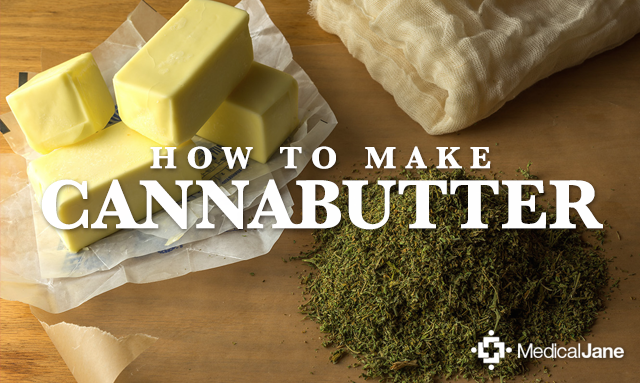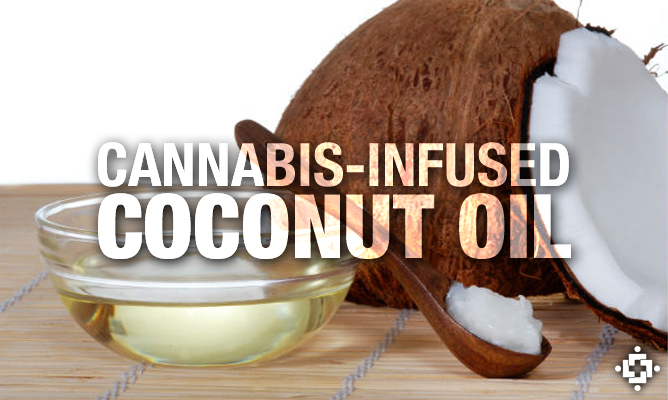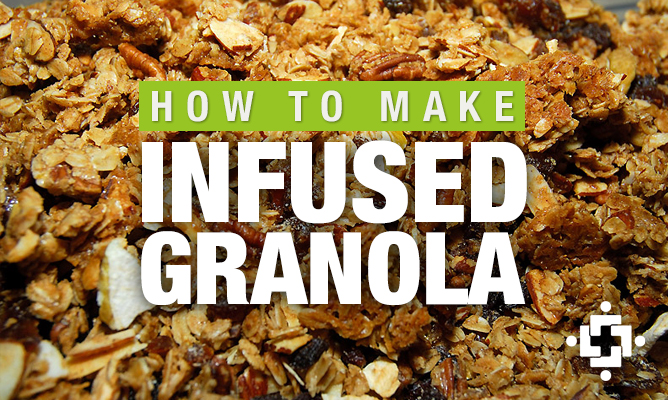Cannabis Infused Coconut Oil How to Make Infused Coconut Oil Making cannabis-infused coconut oil is as simple as steeping quality herb in a quality oil. Machines are available to make cannabis-infused coconut oil, but the infusion process can be done right on a stovetop or hot plate with the help of a double boiler. What You Will Need Double boiler (you can make one if you don’t own one) ¼ to ½ ounce of cannabis 1 cup of coconut oil (organic, expeller-pressed works best for this process) 2-3 feet of cooking twine (a clean unused white shoestring will work in a pinch) Cheesecloth (about an 8” x 10” piece) TIP: A ratio of one quarter ounce of cannabis to one cup of oil is a good starting point. If you want a potent oil, high-quality flower (15%+ THC) works well. However, until you become more comfortable with the process or if you have limited funds, using shake, trim and/or kief work fine (avoid stems and seeds). Cooking Directions Prepare the “herb packet”: Lay the cheese cloth out flat Place the cannabis (breaking up larger pieces) into the middle and distribute evenly over a small area (remember the packet needs to fit into the top pan) Fold in opposite ends to cover the herb Now fold in one of the open ends, tuck and roll Tie the roll of herb tightly with cooking twine (tying a knot in one end and then guiding the twine through it works good) Fill the bottom pan of a double boiler with a few inches of water (allowing enough space so that it does not touch the top pan) and set the shallow pan on top. Place over medium heat to a gentle boil - NOT a rolling boil. Add 1 cup of coconut oil to the top pan. When the coconut oil is almost melted, add about 1 cup of water so that the liquid will cover the herb packet [Note: Coconut oil is nonpolar and water is polar so they will naturally separate when chilled; and THC and CBD are not soluble in water, but are in certain carrier oils. Therefore, the coconut oil acts as the carrier and will “soak” up the cannabinoids, leaving any impurities in the water.] Continue heating the oil and water mixture until all of the coconut oil is melted and then add the herb packet - pressing down gently into the liquid using a metal spoon. Cover and leave to cook for 90 minutes, checking back every half hour or so to flip over the packet and stir it around gently. Also, check the water in the bottom pan to make sure it is not boiling too hard and that the water level is still good - be careful to avoid any escaping steam when removing the top pan. After 90 minutes, the oil and water mixture should be a deep green color. At this point, turn off the heat and remove the herb packet and place in a bowl. Squeeze out any oil that is trapped in the “herb packet” by pressing with a spoon (when it cools down, you can give it another squeeze by hand to get every drop). Add this to the liquid mixture and place in the refrigerator to cool. When the mixture is cooled, the water and oil separate (dirty looking water on the bottom and a nice green color solidified oil containing the good stuff on top). Gently poke 2 or 3 holes through the oil, turn over (holding your hand gently over the oil) and drain the water off. If you are not going to use the oil immediately, store in a container (glass preferred) and label with date, strain and ratio. This will help you determine which strains and in what quantities work best for you. The most important thing to remember is that the effects of consuming cannabis-infused coconut oil (directly or as an ingredient in a cooked dish) are usually slow-acting due to the cannabinoids having to be digested first. As such, it may take up to three (3) hours for you to feel its maximum effects, and those effects could last for awhile. If you find yourself feeling overwhelmed or concerned about overdosing, don’t panic -- no one has ever died as a direct result of consuming cannabis. Choosing the Right Strain Your next choice will be determining what strain(s) of cannabis to use. The infusion process does not drastically change the effects or flavors of the variety of cannabis used. Therefore, you will want to use a cannabis strain that delivers the desired effects you want to achieve (indica, sativa, hybrid, high-CBD). Most importantly, you want to be sure that the cannabis you use is free from impurities (such as mold, fungus, bugs, and pesticides). If the cannabis is compromised, the infusion process will not correct it. Cooking Temperatures Cannabinoids, terpenes and flavonoids are all affected differently by heat. A double boiler traps steam between the pans (provided you have a good seal) and remains steady about 212° F. The most volatile terpenes will start to evaporate around 70° F (filling the air with a pungent aroma). A majority of the remaining terpenes will begin to evaporate rapidly around 100° F. The boiling points of flavonoids range between 273.2° and 352.4° F, so the dominant flavors of the strain you use should still be evident in the infused oil. Cannabinoids, specifically THC and CBD, exist in acidic and activated forms. In the plant, these cannabinoids exist almost entirely in the acidic form and are known as THCA and CBDA. When heated, these acidic forms undergo a chemical reaction called decarboxylation that results in THCA converting to THC and CBDA converting to CBD. Complete activation occurs when heated to 220° F for 90 minutes. In theory, the double boiler cooks at 212° F, but many factors can change that number, so you may need to experiment by adding or subtracting a few minutes to achieve your desired effects. Remember, if you are going to use the oil in a recipe that will expose it to further heat, you don’t want it to be fully activated at this stage. Further, coconut oil has an average smoking point of 350° F, and can be very tricky to cook on direct heat. A double boiler cooks by steam so the oil doesn’t burn easily. Overcooking the oil compromises the fats and the taste will be most unappealing. If this happens, all you can do is throw it out, wipe the pan clean, and start over. Health Benefits Cannabis and coconut oil are what some would call the perfect pair. Coupling coconut oil, “a vegan-friendly super food,” with cannabis, “nature’s miracle plant,” makes a lot of sense. Coconut oil is a saturated oil made primarily of medium-chain fatty acids. It is safe to ingest in edible form and is easily digested. It gets its extra punch from lauric acid (C12), which comprises about 50% of the total fatty acids, and has been linked to many health benefits: reducing abdominal obesity, accelerating healing time for wounds, delivering antioxidant properties, lowering lipid components (e.g. cholesterol, triglycerides), preventing bone loss and more. Some people even use coconut oil as a daily detox. Saturated fats have gotten a bad rap for decades. They have been accused of contributing to high cholesterol, heart disease, obesity, and even Alzheimer’s disease. Much confusion and contradictory evidence exists on the subject, even among health care professionals. Professionals, like Dr. Aseem Malhotra, are trying to set the record straight. Dr. Malhotra gained attention after the publication of his peer-reviewed editorial in the 2013 British Medical Journal (BMJ), wherein he seriously challenged the conventional view on saturated fats, and found no significant association between saturated fat and cardiovascular risk. Coconut Oil Uses There are so many things you can do with cannabis infused coconut oil including: Drizzle over hot cooked pastas, grains, cereals and vegetables Great for sauces and dressings Add to hot cooked soups and stews Use as a poultry rub Pan fry foods like scrambled egg, fish, bananas, chicken Put a spoonful in your coffee, tea or hot chocolate Add to smoothies Types of Coconut Oil Organic, virgin (or extra-virgin), raw, unrefined, centrifuged and cold-pressed are all terms you want to look for when selecting a coconut oil for ingesting with no cooking or for use in low-heat cooking. These oils typically deliver a strong coconut flavor. Organic, refined, expeller-pressed and solvent-free are the terms you are looking for when selecting an oil for baking, sautéing and stir-frying, especially when using higher temperatures. These refined oils also tend to have a lighter coconut flavor. Virgin Oil: Unrefined / Centrifuged Oil True virgin oil is a centrifuged coconut oil produced without using heat. It is considered one of the highest quality oils, but also one of the most expensive coconut oils on the market today. Terms like raw, pure and unrefined are associated with virgin oils. Virgin coconut oil has a more distinct coconut flavor. It is considered by most to be extremely mild and smooth, and can be eaten right off a spoon. Producing high-quality virgin oil is timely and expensive. Using a machine (centrifuge) cooled by chilled water, coconut cream is produced from pressing the fresh, white meat of the coconut and then concentrating it to yield more and more oil while the proteins and water soluble constituents are separated out and more of the phytonutrients are preserved. Unlike olive oil and some of the other oils, there are no standards to be met in the coconut oil industry to claim extra-virgin status. It is mostly a buzz word used for marketing. Cold-pressed Oils Cold-pressed coconut oils are also often referred to as raw or unrefined. The extraction method used to produce these oils is very similar to the centrifuged method used to make virgin coconut oils. The cold-pressing method however uses a drying process, which can be accomplished using varying degrees of heat. Therefore, very few cold-pressed oils are truly virgin oils. The method of drying and amount of heat used will determine the quality and taste of the coconut oil. Oils processed at high temperatures may taste of toasted coconut, while those processed at lower temperatures tend to deliver more of a mild, raw coconut flavor. If the oil was poorly processed, it may exhibit burnt or rancid qualities. Refined or RBD Coconut Oils Most coconut oils available on the market today are refined or RBD (refined, bleached and deodorized). If a label doesn’t say it is otherwise, then it is most likely refined. These are typically the least expensive of all coconut oils. Refined coconut oil should deliver a light, delicate flavor. The refining process strips away some of the nutrients, but it doesn’t have to alter other attributes of the coconut oil (such as fatty acid profile, taste, aroma). The methods for producing refined oils varies significantly, and can be accomplished with or without harsh solvents (like lye or hexane). If a product doesn’t say it is solvent free, it is a safe bet it was chemically processed and you should avoid it. Otherwise, RBD oils are fine to use, especially for cooking. Bleaching simply refers to the filtering process to remove impurities and is generally not a chemical process. Organic usually signifies that no harsh chemicals or solvents were used in the production. Expeller-pressed Extraction Method The expeller-pressed extraction method is used to produce RBD oils. During production the coconut meat is dried (most often by sun or smoke) and then pressed in large expeller presses. The resulting coconut oil is crude and must be refined or cleaned to minimize free fatty acids, remove remaining moisture, and minimize bad flavors or aromas. Expeller-pressed coconut oils can be a good option if you do not want to pay the premium for virgin oils. They are also a good option for those who do not like the taste of coconuts, or don’t want a strong coconut flavor for baking, sautéing and stir-frying, certain foods. Just be certain that no chemicals or solvents were used in the process. MCT Oil Medium-chain triglycerides (MCTs) are a form of saturated fatty acid that has numerous health benefits. Coconut oil is one great source of MCTs. Roughly 65% of the fatty acids in coconut oil are medium-chain triglycerides. There are four kinds of MCTs: caproic (C6), caprylic (C8), capric (C10) and lauric (C12) acids. Generally speaking, the shorter the chain (meaning the lower the number of carbons the acid has), the faster the body can turn the fatty acids into ketones (usable energy). MCT oil is not an oil found in nature, but is instead manufactured by machine. The fatty acids are extracted through an industrial process of fractionation and concentrated into MCT oil. The logic is that since MCTs are healthy, the more the better. However, lauric acid (C12) is totally void, or present only in minuscule amounts in MCT oil. This has caused much debate on the matter. One side argues that MCT oils don’t include lauric acid because it is rare and more costly to include, and the other side argues that C12 is a less efficient way to obtain energy and adds nothing extra to the product. MCT oil makers advocate using only C8 and C10 (or 100% of one or the other) because they are the most rapidly metabolized for energy. Choosing between coconut oil and MCT oil, or deciding which one is better, should not be a concern when you understand the differences. On one hand, coconut oil is high in lauric acid which has well-documented health benefits, and MCT oil has very little to offer in that way. On the other hand, MCT oil may help raise energy levels better than coconut oil, but little proof is available to validate this claim. If you do plan to use an MCT oil, be sure the label clearly lists the ingredients and discloses how it was produced. Many MCT oils are chemically altered and contain unhealthy fillers like polyunsaturated fats, and due to their refining process may use harsh solvents and chemicals in manufacturing. Storage and Shelf-Life Be sure to keep the infused oil in a container with a tight lid (insects and critters love it). A glass jar with a wide mouth works well so that you can scoop it out easily. The infused oil should be kept out of direct sunlight. It can be refrigerated, but it is not necessary. It can also be frozen, but freezing it will change the taste - sometimes for the better but sometimes for the worse. Coconut oil is very stable and depending on the kind, can last anywhere from 18 months to several years. Opinions differ on how long cannabis-infused oil can be kept. Most agree that degradation begins after 2-3 months, and sooner after repeated exposure to air (opening and shutting the jar) or overexposure to sunlight or heat. This does not mean it is unusable, but you will definitely start to notice a change in the taste and effectiveness as the cannabinoids begin to degrade.



